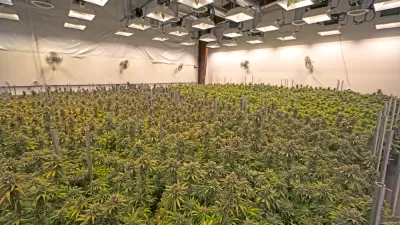Officials overseeing cannabis implementation are having to deal with residents’ complaints that the smell from marijuana operations is overwhelming.

Recreational cannabis has been legal in California since January, but one part of implementation and regulation is proving challenging. In counties throughout the state, residents describe the smells emanating from commercial operations as something akin to skunk, rotting lemons, and sulfur, reports Thomas Fuller:
"It’s as if a skunk, or multiple skunks in a family, were living under our house," said Grace Guthrie, whose home sits on the site of a former apple orchard outside the town of Sebastopol. Her neighbors grow pot commercially. "It doesn’t dissipate," Ms. Guthrie said. "It’s beyond anything you would imagine."
Cannabis growers say that smells are an expected part of agricultural operations, but municipalities were not prepared for odor to be a primary issue related to marijuana production. "Of the more than 730 complaints Sonoma County has received about cannabis this year, around 65 percent are related to odor, according to Tim Ricard, the county’s cannabis program manager," says Fuller.
Residents in Sonoma County are calling for a ban on cannabis operations; Mendocino County has established zones where it is prohibited. Odor-control systems are another strategy for dealing with the stink, but this equipment is expensive and many operators cannot afford it.
Also, part of the problem for local officials is developing a standard for smells, which can be subjective and hard to quantify. Colorado, which legalized cannabis in 2014, uses a device called the Nasal Ranger to measure odor levels. California, however, has yet to adopt this technology.
FULL STORY: ‘Dead Skunk’ Stench From Marijuana Farms Outrages Californians

Alabama: Trump Terminates Settlements for Black Communities Harmed By Raw Sewage
Trump deemed the landmark civil rights agreement “illegal DEI and environmental justice policy.”

Planetizen Federal Action Tracker
A weekly monitor of how Trump’s orders and actions are impacting planners and planning in America.

Why Should We Subsidize Public Transportation?
Many public transit agencies face financial stress due to rising costs, declining fare revenue, and declining subsidies. Transit advocates must provide a strong business case for increasing public transit funding.

Understanding Road Diets
An explainer from Momentum highlights the advantages of reducing vehicle lanes in favor of more bike, transit, and pedestrian infrastructure.

New California Law Regulates Warehouse Pollution
A new law tightens building and emissions regulations for large distribution warehouses to mitigate air pollution and traffic in surrounding communities.

Phoenix Announces Opening Date for Light Rail Extension
The South Central extension will connect South Phoenix to downtown and other major hubs starting on June 7.
Urban Design for Planners 1: Software Tools
This six-course series explores essential urban design concepts using open source software and equips planners with the tools they need to participate fully in the urban design process.
Planning for Universal Design
Learn the tools for implementing Universal Design in planning regulations.
Caltrans
Smith Gee Studio
Institute for Housing and Urban Development Studies (IHS)
City of Grandview
Harvard GSD Executive Education
Toledo-Lucas County Plan Commissions
Salt Lake City
NYU Wagner Graduate School of Public Service





























